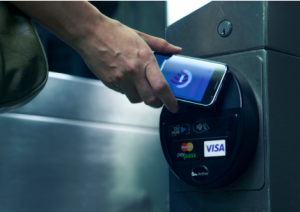
Broadcom thinks it can make NFC a common smartphone feature by offering it in a chip with other wireless technologies, even if making payments with the technology doesn’t catch on for years.
On Tuesday, the communications chip company announced what it called the first chip with built-in Wi-Fi, Bluetooth, FM radio and NFC (near-field communication), which it said should start appearing in handsets next year.
Getting NFC in the same chip it uses for the ubiquitous Wi-Fi and Bluetooth technologies will make it much easier and cheaper for smartphone makers to integrate the technology in their products, Broadcom executives said at a press event on Tuesday. The event was designed partly as a preview of the International Consumer Electronics Show next month, with demonstrations of technologies such as Miracast mobile-to-TV video streaming that Broadcom expects to see at CES.
Until now, vendors have had to buy a separate chip for NFC and work it into their internal designs, taking up extra space in the tight quarters of a phone’s circuitry. More integration also cuts power consumption, Broadcom says.
The BCM 43341 chip just introduced will have the same effect on NFC that earlier combined chips had on Wi-Fi, said Michael Hurlston, senior vice president and general manager of Broadcom’s Mobile and Wireless Group.
“When we were able to do a combo device with Bluetooth and wireless LAN, it really made Wi-Fi go to a 100 percent attach rate in the smartphone,” Hurlston said. “We think that by doing something similar with NFC, it will accelerate and further drive the adoption of NFC.”
That adoption won’t depend totally on NFC mobile payments catching on, according to Broadcom. Initially, it will be driven by applications that don’t need as complex an ecosystem. For example, NFC will play a key role in Miracast, a system for transferring video among devices via Wi-Fi, said Mohamed Awad, an associate product line director.
In a demonstration, Awad tapped a Google Nexus 4 handset to a Google Nexus 10 tablet to initiate a Miracast session. NFC was the network medium for the “handshake” between the devices, and then the faster Wi-Fi system took over to send the content.
NFC tapping will help make Miracast catch on because it’s much simpler for consumers than setting up the connection via software, Awad said. Software-based setup for applications based on Wi-Fi Direct, including Miracast, is sometimes hard because devices have different user interfaces for the process, he said.
NFC also sets up wireless streaming in Samsung Galaxy S III phones, which lets users share video or images between the handsets at close range. Samsung has heavily promoted the feature in ads. “We’ve seen people actually doing it in the wild,” Hurlston said.
Broadcom also believes NFC payments will catch on, but not until after more users become comfortable with the technology through uses closer to home. Awad estimated wide adoption of payments would take two to three years. “I absolutely believe payments is going to happen,” he said.





